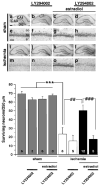Neuroprotective action of acute estrogens: animal models of brain ischemia and clinical implications
- PMID: 23385013
- PMCID: PMC3733348
- DOI: 10.1016/j.steroids.2012.12.015
Neuroprotective action of acute estrogens: animal models of brain ischemia and clinical implications
Abstract
The ovarian hormone 17β-estradiol (E2) exerts profound neuroprotective actions against ischemia-induced brain damage in rodent models of global and focal ischemia. This review focuses on the neuroprotective efficacy of post-ischemic administration of E2 and non-feminizing estrogen analogs in the aging brain, with an emphasis on studies in animals subjected to a long-term loss of circulating E2. Clinical findings from the Women's Health Initiative study as well as data from animal studies that used long-term, physiological levels of E2 treatment are discussed in this context. We summarize major published findings that highlight the effective doses and timing of E2 treatment relative to onset of ischemia. We then discuss recent findings from our laboratory showing that under some conditions the aging hippocampus remains responsive to E2 and some neuroprotective non-feminizing estrogen analogs even after prolonged periods of hormone withdrawal. Possible membrane-initiated signaling mechanisms that may underlie the neuroprotective actions of acutely administered E2 are also discussed. Based on these findings, we suggest that post-ischemic treatment with high doses of E2 or certain non-feminizing estrogen analogs may have great therapeutic potential for treatment of brain damage and neurodegeneration associated with ischemia.
Copyright © 2013 Elsevier Inc. All rights reserved.
Figures






Similar articles
-
Different methods for administering 17beta-estradiol to ovariectomized rats result in opposite effects on ischemic brain damage.BMC Neurosci. 2010 Mar 17;11:39. doi: 10.1186/1471-2202-11-39. BMC Neurosci. 2010. PMID: 20236508 Free PMC article.
-
Acute administration of non-classical estrogen receptor agonists attenuates ischemia-induced hippocampal neuron loss in middle-aged female rats.PLoS One. 2010 Jan 8;5(1):e8642. doi: 10.1371/journal.pone.0008642. PLoS One. 2010. PMID: 20062809 Free PMC article.
-
Estradiol attenuates ischemia-induced death of hippocampal neurons and enhances synaptic transmission in aged, long-term hormone-deprived female rats.PLoS One. 2012;7(6):e38018. doi: 10.1371/journal.pone.0038018. Epub 2012 Jun 4. PLoS One. 2012. PMID: 22675505 Free PMC article.
-
The use of estrogens and related compounds in the treatment of damage from cerebral ischemia.Ann N Y Acad Sci. 2003 Dec;1007:101-7. doi: 10.1196/annals.1286.010. Ann N Y Acad Sci. 2003. PMID: 14993044 Review.
-
Neuroprotective actions of estradiol and novel estrogen analogs in ischemia: translational implications.Front Neuroendocrinol. 2011 Aug;32(3):336-52. doi: 10.1016/j.yfrne.2010.12.005. Epub 2010 Dec 14. Front Neuroendocrinol. 2011. PMID: 21163293 Free PMC article. Review.
Cited by
-
Estrogen administration modulates hippocampal GABAergic subpopulations in the hippocampus of trimethyltin-treated rats.Front Cell Neurosci. 2015 Nov 5;9:433. doi: 10.3389/fncel.2015.00433. eCollection 2015. Front Cell Neurosci. 2015. PMID: 26594149 Free PMC article.
-
Astrocytic response to cerebral ischemia is influenced by sex differences and impaired by aging.Neurobiol Dis. 2016 Jan;85:245-253. doi: 10.1016/j.nbd.2015.03.028. Epub 2015 Apr 2. Neurobiol Dis. 2016. PMID: 25843666 Free PMC article. Review.
-
In Vitro Neuroprotective and Anti-Inflammatory Activities of Natural and Semi-Synthetic Spirosteroid Analogues.Molecules. 2016 Jul 29;21(8):992. doi: 10.3390/molecules21080992. Molecules. 2016. PMID: 27483221 Free PMC article.
-
Development of a new cerebral ischemia reperfusion model of Mongolian gerbils and standardized evaluation system.Animal Model Exp Med. 2024 Feb;7(1):48-55. doi: 10.1002/ame2.12378. Epub 2024 Feb 19. Animal Model Exp Med. 2024. PMID: 38372486 Free PMC article.
-
Steroids in Stroke with Special Reference to Progesterone.Cell Mol Neurobiol. 2019 May;39(4):551-568. doi: 10.1007/s10571-018-0627-0. Epub 2018 Oct 9. Cell Mol Neurobiol. 2019. PMID: 30302630 Free PMC article. Review.
References
Publication types
MeSH terms
Substances
Grants and funding
LinkOut - more resources
Full Text Sources
Other Literature Sources

